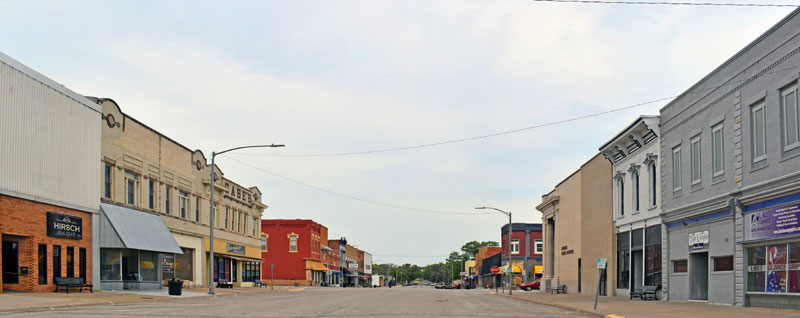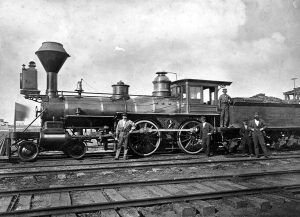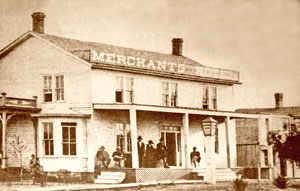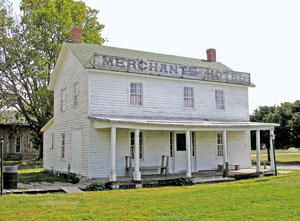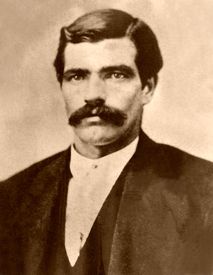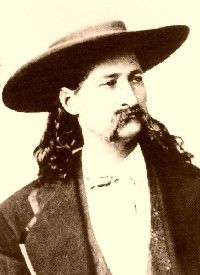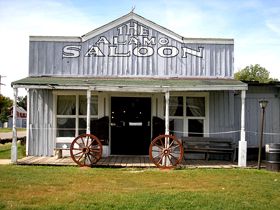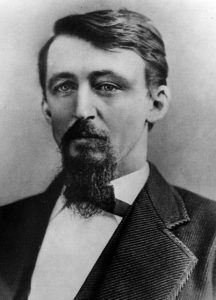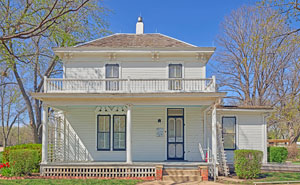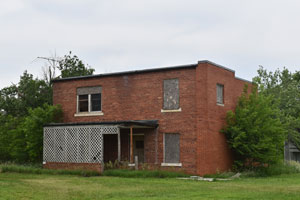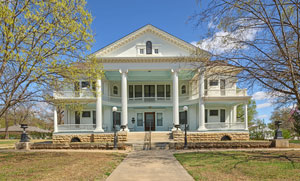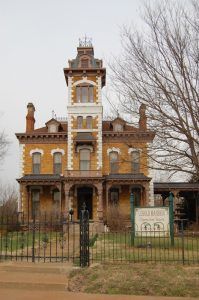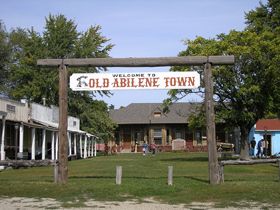Abilene, Kansas, in Dickinson County, was located on the north bank of the Smoky Hill River, about 95 miles west of Topeka, Kansas. It is the county seat and largest city of Dickinson County. Though best known as the Queen of Kansas Cowtowns, Abilene already existed for a decade before the cattle drives arrived.
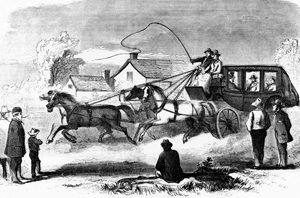
The Butterfield stage line.
First settled in 1858, it was named by Timothy and Eliza Hersey from a passage in the Bible, meaning “city of the plains.” The first terminus and later a station on the Butterfield Overland Stage Line, the Hersey’s secured a contract with the company to feed the passengers and employees. The establishment, consisting of two log houses, a log stable, and a horse corral, advertised to the westbound traveler: “the last square meal east of Denver.”
The following structure was built: a dwelling known as “the Hotel,” owned by C. H. Thompson and located on the east bank of Mud Creek. More homesteaders began to come to the area, and among one of them was a man commonly known as “Old Man Jones,” who erected a log house that he turned into a store, selling some limited supplies, but mostly whiskey.
Seeing the coming of statehood for the Kansas Territory, C.H. Thompson laid out the town in 1860, hastily constructing some makeshift log houses to give it some semblance of a town. A post office opened on December 6, 1860.
However, its sleepy little existence changed when a livestock dealer from Illinois, Joseph G. McCoy, saw Abilene as the perfect place for a railhead from which to ship cattle. McCoy chose the site because of the area’s abundance of grass and water. Before the town developed into a major shipping center, McCoy described it as:
“Abilene in 1867 was a very small, dead place, consisting of about one dozen log huts, low, small, rude affairs, four-fifths of which were covered with dirt for roofing; indeed, but one shingle roof could be seen in the whole city. The business of the burg was conducted in two small rooms, mere log huts, and of course, the inevitable saloon, also in a log hut, was to be found.”
The following year, Abilene became the Dickinson County Seat. In 1864, Dr. W. S. Moon built the Frontier Store east of the creek, carrying a small general merchandise stock. Moon became the first postmaster as well as the Registrar of Deeds. The town’s growth was relatively slow until after the Kansas Pacific Railroad was completed to Abilene in 1867.
But McCoy would change that. He soon sent circulars all over Texas advertising Abilene as a new shipping point and built a stockyard and a hotel called the “Drover’s Cottage.” Before the close of 1867, some 35,000 cattle had been driven there for shipment on the new railroad to the eastern markets. Under his leadership, the town reigned as the primary market for Texas cattle for four years.
Theodore C. Henry came to Abilene from Illinois in 1867 to help promote McCoy’s stockyards. Working in real estate promotion, he and his partners also became involved in local politics. Henry advocated the cattle trade, which began in Kansas in 1868.
Though the new shipping point spurred the town’s growth, it also attracted many undesirable characters, including gamblers, confidence men, cowboys, soiled doves, and others. Much to the chagrin and disgust of the reputable, law-abiding citizens, these “undesirables” practically took possession of the place. Shooting affrays were common. Being in the majority, the turbulent element continued to run things with a high hand until the probate court of Dickinson County granted a petition to incorporate Abilene on September 6, 1869. Joseph G. McCoy was chosen as the first mayor, and the new city government began taking steps to curb the prevailing lawlessness.

Broadway Avenue, Abilene, Kansas 1875.
The town began to build a stone jail, but a band of cowboys tore it down about the time the walls were up. In 1870, a new brick-and-stone courthouse was built at Broadway and Second Streets. The same year, the much-needed Merchant’s Hotel was built by Kerney & Guthie, a two-story building that provided lodging for many cowboys.
In 1870, Theodore Henry became Abilene’s provisional mayor. By then, he had begun to oppose the cattle trade, which was unpopular with many for various reasons.
Desperately seeking a lawman, the City of Abilene hired Thomas J. “Bear River” Smith, who had come to Abilene from Kit Carson, Colorado, as the town’s first Chief of Police on June 4, 1870. At the time, it was said that his appearance was against him, but what he lacked in physical strength was more than made up in courage and diplomacy. One of his first official acts was to order that no one could carry a firearm within the city limits without a permit. Smith’s ability was well enough respected that even the most troublesome cowboys and gamblers obeyed.
Known as the “No Gun Marshal,” he gained a reputation for subduing assailants with his fists rather than a gun. He disarmed most of the desperate characters within a short time, bringing about a reign of law and order.
But Smith’s Abilene career would be cut short on November 2, 1870, when he attempted to arrest an accused murderer named Andrew McConnell. The outlaw shot Smith, but the lawman returned fire, wounding McConnell, before falling to the ground. McConnell’s co-conspirator in the original crime, a man named Miles, then struck Smith with his gun, grabbed an ax, and nearly chopped Smith’s head from his body. McConnell was sentenced to twelve years in the state penitentiary, and Miles received a 16-year sentence for their gruesome crime.
Tom Smith’s successor as a city marshal was the famous Wild Bill Hickok, well-known before coming to Abilene for his deadly marksmanship and gunfighting skills. Appointed on April 15, 1871, Wild Bill first tended to routine business, using his deadly twin pistols to prevent several murders and the destruction of property throughout the town. Early on, Hickok ran into the likes of John Wesley Hardin, whom Hickok befriended until Hardin shot a man and fled Abilene.
However, Hickok spent most of his time at the Alamo Saloon, the center of town’s nightlife, and was not too friendly with Abilene’s “upstanding” folks. Instead, he spent more time at the gaming tables and with the ladies of the evening than he did taking care of his sheriff duties.
Though he stopped the gunplay simply with his reputation and convinced the renegade cowboys that he meant business and that the law would be enforced, he made little other attempt to “clean up” the town.
However, Wild Bill did have to do some marshaling when shots were heard near the Alamo Saloon on October 5, 1871. Discovering that it was a man named Phil Coe who had shot at a dog that had tried to bite him, Wild Bill explained to Coe that firearms were not allowed in the city.
But, for whatever reason, all hell broke loose, and Coe sent a bullet Hickok’s way. Bill returned the fire and shot Coe twice in the stomach. Suddenly, Hickok heard footsteps coming up behind him, and turning swiftly, he fired again and killed Deputy Mike Williams. Coe died three days later. (See Hickok-Coe Gunfight)
By this time, Abilene had had enough. The city fathers told the Texans there could be no more cattle drives through their town and, two months later, dismissed Hickok as city marshal. It was the last big year for Abilene, as more than 40,000 head of cattle were shipped out by rail. New railheads were built to Newton, Wichita, and Ellsworth, becoming the favored shipping points. During its four-year reign, over three million head of cattle were driven up the 1,000-mile Chisholm Trail and shipped from Abilene. With the cowboys gone, the town became a peaceful, law-abiding community.
In the meantime, Theodore Henry introduced wheat to Kansas by secretly planting 5,000 acres. Throughout the 1870s, he experimented with planting Turkey red winter wheat, a crop commonly thought not to grow well in Kansas. He introduced the seed to others after seeing that it produced a successful wheat crop. At one time, Henry owned thousands of acres between Abilene and Enterprise. Henry had several large crop yields and, by the mid-1870s, was known by many as the “Wheat King of Kansas.” Henry’s large carriage house, which once stood near the corner of 14th and Buckeye streets in Abilene, can still be seen today at Old Abilene Town.
In 1881, Abilene, Texas, was named after Abilene, Kansas.
Later, Abilene could make another claim to fame when President Dwight D. Eisenhower’s family moved there from Denison, Texas, in 1892. Eisenhower attended elementary and high school in the city and always called it “home.” Eisenhower would later become the 34th President of the United States. When he died, it became his final resting place, along with his wife, Mamie, and one son. Today, his Presidential Library, Museum, & Boyhood Home remain in Abilene.
In 1888, the Sisters of St. Joseph of Concordia, Kansas, came to Abilene and established the St Joseph School for Girls. The academy continued to operate until 1912. Afterward, it was renovated in 1915, and the Concordia sisters opened it as an orphanage and home for the aged. Sister Xavier Cunningham began work as a nurse for the home. Sister Xavier, who had farming experience, also became a farmer to provide the facility’s residents with milk, meat, eggs, and vegetables. A family from Beloit, Kansas, donated the first milk cow; before long, a registered Holstein herd had been established.
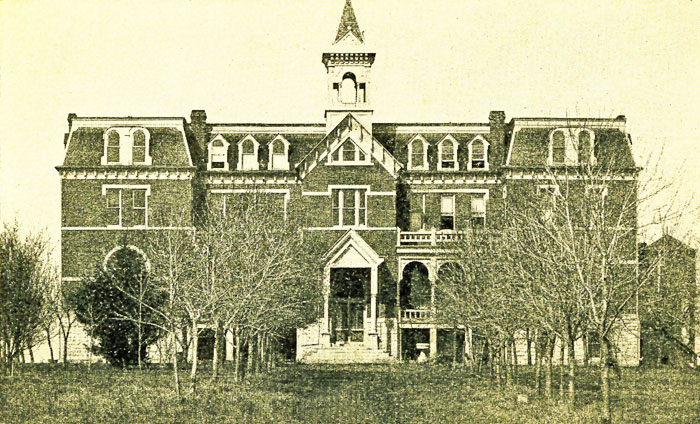
St. Joseph Orphanage in Abilene, Kansas.
By 1924, a home for elderly residents had been built, and the facility became an orphanage, with as many as 80 children living there at any one time.
Over the years, the Holstein breeding stock was sold over a large area of the state by the St. Joseph’s farm. Additionally, a dairy operated a retail milk route in Abilene. The farm once had 40 cows, 500 hens, and 12 brood sows. Many vegetables and fruits, such as apples and peaches, were grown, and a vineyard was used for grapes. Not only did Sister Cunningham create a means to feed the children, was also able to raise funds to keep the program running well past the Great Depression and provide jobs for many of the boys who lived there. Sister Cunningham retired from the orphanage in 1944 due to poor health.
As child welfare laws changed and the foster care system was implemented, the orphanage closed in 1958 after the building was deemed unsafe. The following year, the orphanage building was torn down.
The facility was located just north of Abilene on Buckeye Avenue. On the east side of the road was the farm and dairy, which later became home to several businesses, including the Brookville Hotel. The orphanage’s site is marked by red brick pillars, each with a white cross. Inside the pillars is an old stone grotto and the old brick rectory with its statues long gone. The Salina Diocese still owns the property, and there are no plans to develop or sell it.
In 1899, the Brown Telephone Company was founded in Abilene, Kansas, by Cleyson L. Brown to bring telephone service to the rural area around Abilene. The company installed its first long-distance circuit in 1900, becoming an alternative to the Bell Telephone Company, the most popular telephone service. In 1911, the Brown Telephone Company consolidated with three other independents to form the United Telephone Company. Later, this organization would become the basis for the Sprint Corporation.
Dr. A.B. Seelye built a beautiful 11,000-square-foot home in 1905. Seelye had created a patent-medicine company in Abilene, covering 14 midwestern states and carrying over 100 products. Today, the Georgian-style Seelye Mansion is like a time capsule. Most of the home’s furnishings were purchased at the 1904 St Louis World’s Fair and remain in the home today. The furnishings cost more than $55,000. The Patent Medicine Museum occupies a former Seelye laboratory, which has been moved to the mansion’s rear. Today, the Seelye Mansion is a popular location for weddings and other special events and can be toured by appointment.
By 1910, Abilene had moved on and boasted a population of 4,118. Its location at the junction of the Union Pacific, Chicago, Rock Island & Pacific, and the Atchison, Topeka & Santa Fe Railroads made it an important shipping point. Large quantities of grain and livestock were exported annually. By this time, the city had also diversified, with several manufacturers, including flour mills, creameries, foundries, an organ factory, planing mills, cigar factories, carriage factories, ice factories, and more.
Today, the City of Abilene is a diversified agricultural community boasting a population of some 6,500 people. It remains the county seat of Dickinson County.
The city provides several museums and attractions featuring its rich history, including the Eisenhower Center, consisting of a Visitors Center, Presidential Museum, Research Library, and the original Eisenhower family home; the Dickinson County Historical Museum, which features life on the plains during the westward expansion period; the C.W. Parker Carousel, a 1900 National Landmark; American Indian Art Center dedicated to promoting Native American artists in the region, and more.
An absolute “must-see” in Abilene is the reconstructed “Old Abilene Town.” An authentic replica of the cattle capital as it was during its roaring heyday, Old Abilene Town is not far from the original townsite. Though most buildings have been recreated, several, including the log structures and the red schoolhouse, are the originals.
They were moved to the site and rebuilt. The Merchant’s Hotel is a replica of the original hotel of the same name. The Alamo Saloon is a replica of the most famous early-day house, which was kept open around the clock to entertain cowboys.
The site is open all year, but from May through October, gunfighters can be seen on the main street several times a day on weekends, and stagecoach rides are available.
The Abilene & Smoky Valley Railway also provides excursion tours of the Smoky Hill River Valley on weekends from May through October. In May of 2025, a USA Today nationwide poll named the route through the Smoky Hill River Valley to Enterprise, Kansas, as the fifth most scenic train ride in America.
Old Abilene Town is located at 200 SE 5th Street in Abilene.
More Information:
City of Abilene
P.O. Box 519
201 NW Second St.
Abilene, Kansas 67410
785-263-2231 or 800-569-5915
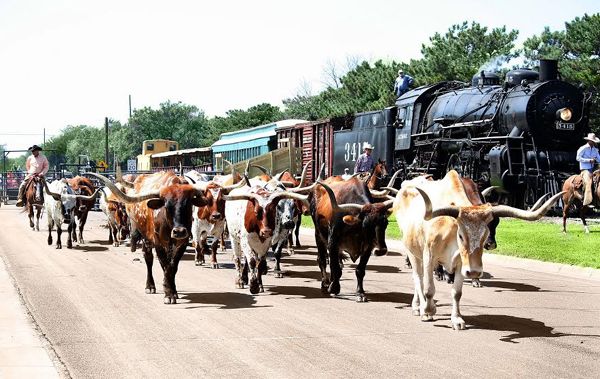
Cattle in Abilene, Kansas, next to the scenic railroad.
© Kathy Alexander/Legends of America, updated November 2025.
Also See:
Joseph G. McCoy – Kansas Cattle Baron
Kansas Cowtowns – Lawlessness on the Prairie
Thomas “Bear River” Smith – Marshalling Abilene
Wild Bill Hickok & The Dead Man’s Hand
Sources:
Abilene, Kansas History
Blackmar, Frank W.; Kansas: A Cyclopedia of State History, Vol I; Standard Publishing Company, Chicago, IL 1912.
Cutler, William G.; History of Kansas; A. T. Andreas, Chicago, IL, 1883.
Kansas State Historical Society
Nazarath Convent and Academy
Dickinson County Historical Society

